 After the article on the remote controlled camera, we were asked if the Yoctopuce modules could be used to take pictures of scenes notoriously difficult to capture, such as a bursting balloon. We had to respond to the challenge!
After the article on the remote controlled camera, we were asked if the Yoctopuce modules could be used to take pictures of scenes notoriously difficult to capture, such as a bursting balloon. We had to respond to the challenge!
The idea is to inflate a party balloon with an explosive gas and to literally make it blow up while taking a picture of it. As we are very likely to have to make numerous attempts, we are going to build an automatic system which will take care of inflating the balloon, of making it explode, and of taking the picture. Non negligible advantage, this allows us to witness the experiment from afar.
Inflating the balloon
We must therefore fill the balloon with an explosive mix, that is a combustible gas and an oxidant. We want ideal proportions for this mix so that we have an optimal explosion: we would like to take a picture of something spectacular, not simply a large flame.
It so happens that there is a relatively simple and available manner to fulfil these conditions: the electrolysis of water. Indeed, when electricity goes through water, water molecules (H2O) reorganize themselves into hydrogen molecules (H2) and oxygen molecules (O2). We then obtain a fuel and oxidant gaseous mix in ideal proportions.
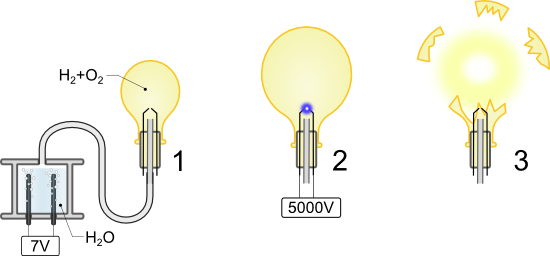
The idea is to produce oxygen and hydrogen, to inflate a balloon with them, and to make it explode.
For the experiment, we built a Plexiglas tank equipped with two electrodes. A flexible tube comes out of this tank and is connected to the balloon.

We built an electrolysis tank in Plexiglass
Important security advice: when exploding, the balloon must imperatively be isolated from the tank, otherwise the explosion will propagate itself to the tank, make it burst, with all the implied risks. We settled the issue by filling the tank to the maximum to make sure as little gas as possible would accumulate in it and by installing an electrovalve between the tank and the balloon.
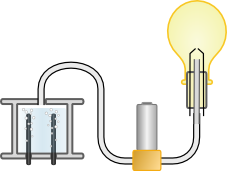
The tank and the balloon must be isolated from one another. Here we use an electrovalve.
We reused the remote controlled socket strip used in the experiment described in this article, and we connected to it the electrolysis power supply and the 24V power supply of the electrovalve. Therefore, as soon as we activate the strip, the electrovalve opens and the electrolysis starts. As soon as we switch the strip off, the electrolysis stops and the electrovalve closes. Finally, we put a Yocto-Watt between the tank and its power supply. In this way, we can monitor how much energy we inject into the tank. The quantity of the produced gas is directly proportional to this energy. This enables us to control how much gas comes into the balloon.

The full mechanism to inflate the balloon
Firing
After reaching this point, we have a party balloon filled with a gaseous mix which wants only one thing: to recombine itself into water molecules while brutally restituting all the energy which was used to produce it. In short, any spark would be enough to make it explode. After some tests, we selected a flash lamp from a disposable camera.
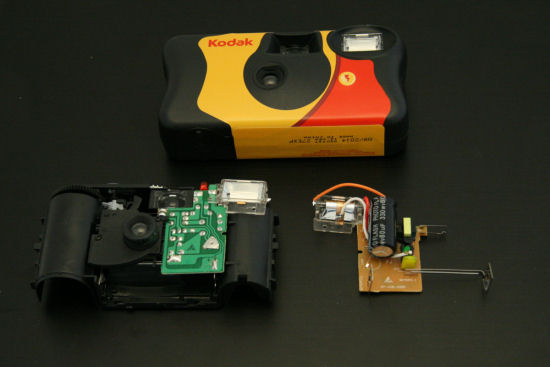
You can make very nice sparks out of the flash of a disposable camera
An electronic flash is made of a glass bulb in which an electric arc is triggered between two electrodes. In fact, a flash bulb has three poles: one at each end, and a third one used to energize the tube by ionizing the gas within the bulb with the help of a high tension.
We are interested in this third pole: when we press the trigger, a tension of several thousands of volts appears between the mass of the tube and this pole. This is enough to produce a spark between two electrodes distant of a short millimeter.
As you will have understood, taking a flash apart entails some risks. A flash electronics contains components which can generate considerable voltage from a simple battery. In particular, there is a large capacitor which can be charged up to 300V even without the battery. This capacitor can be neutralized by short-circuiting its ties with an isolated screw driver (beware of the spark).
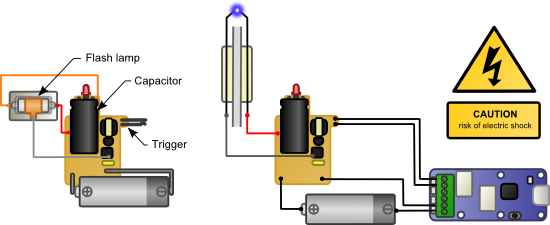
Flash circuit rewiring
For the experiment, we connected the power supply and the trigger of the flash electronics on a Yocto-Relay. The two wires of the flash bulb are connected to electrodes which are inside the balloon inflated with hydrogen and oxygen. We only need to power the electronics for a good ten seconds to charge the capacitor, then to short-circuit the trigger contacts to produce a spark between the two electrodes.
To create a spark inside the inflated balloon, we built a tip which is nothing more than a Plexiglass tube, filled with resin and through which goes a tube for the inflating, and two bits of piano wire acting as electrodes.

The balloon inflating tip
Software
The hardware part is done. The software part is relatively easy. We write a short piece of software which turns on the socket strip, this opens the electrovalve and starts the electrolysis. We must then monitor the Yocto-Watt and shut off the strip power supply when we have reached the selected energy level, 10Wh for example. At 7V@10A, it takes about 10 minutes to inflate the balloon. Once the balloon is inflated, we charge the balloon by providing power for about 10 seconds.
We then only need to trigger the spark and the camera with the correct interval, taking into account the fact that the camera needs a few tens of ms to effectively take the picture. To determine the ideal interval, we tried to photograph the spark. To do so, we used a dichotomic method:

Empirical calculation of the ideal interval between the firing and picture taking commands
We started with an exposure time of one second and we triggered the camera and then the spark with a 0ms delay. If everything functions correctly, we will necessarily take a picture of the spark. Then we divide the exposure time by half and we take two pictures, one with a 0ms interval and the second with a 500ms interval. The spark appears only on one of the two pictures. We iterate the operation about 10 times, dividing the exposure time by half and adding, if necessary, the exposure time to the interval. We thus determine the ideal value for the interval with a 1 ms precision. No need to go lower: UBS 1.1 threads are sent every ms.
Triggers are performed with the help of the delayedPulse function of the Yocto-Relay. Thus, the timings are performed directly in the Yocto-Relay and depend neither on the monitoring computer nor on USB transmission delays.
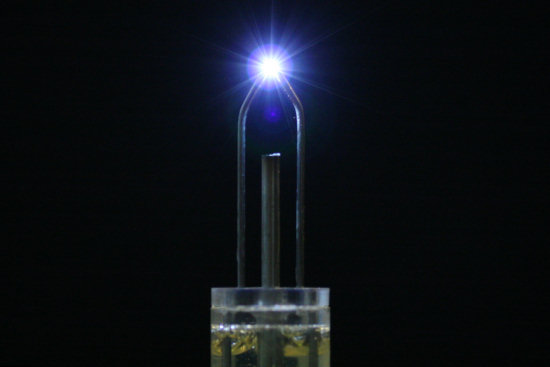
We take a picture of the spark to determine the correct timing. Believe it or not, we didn't edit the picture.
As we don't want to stay close to the apparatus when it is working, we coded everything as a small web server. This enables us to control the setup from a smartphone with wifi access, while staying at a safe distance. We can never be too prudent.

The experiment is controled from a smart phone
Fire in the hole
Well, we dealt with every aspects of the experiment, we now need to try it out. All staff is requested to leave the experiment area.
Here are some of the pictures taken automatically during the experiment. The explosion lasts about 5 milliseconds, during which it takes the same shape as a flame, before vanishing entirely.

Boom.
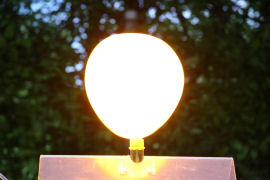
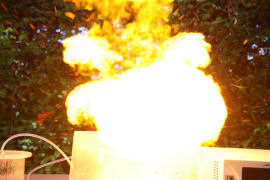
On right: note the projected balloon fragments

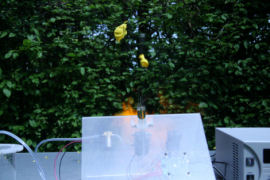
Beware! Danger!
Obviously, we strongly discourage you to try to reproduce this experiment at home. Nevertheless, if you still want to do so, be extremely careful. This experiment includes numerous risks which may lead to serious injuries.

Use you head, think, and do not try this alone. Moreover, you must know that we have deliberately kept some details of the actual experiment hidden. This will force you to think it through before you go ahead.


